Cemeteries aren’t the first place that springs to mind when looking for art, especially nowadays when tombstone design is expensive. Finding stonecutters can also be problematic. In the 19th and early 20th centuries, renowned architects and sculptures did create works to memorialize a client or themselves. These memorials were also a way to show that a family was prominent and deserved respect even in death. Each cemetery can restrict the type of monuments or memorials allowed. The art in Bohemian National Cemetery and Rosehill Cemetery reflect their founders intellectual and artistic beliefs.
Born from a battle where the Catholic relative of free thinkers was denied burial in a Catholic cemetery, Bohemian National maintains an inclusive attitude towards memorials, tombstones, and mausoleums. The memorials contain examples of limestone statuary, photography, Art Deco imagery, and Chicago Cubs logos.
The limestone trees are the most striking memorials in Bohemian National.
Each tree is unique, although certain symbols are repeated. A cluster of houbys appears at the bottom. The bent branch references a life ended. The oak leaves symbolize strength.
The mausoleums tend to reference Art Deco. The most famous person buried at Bohemian National is buried in one such mausoleum: Anton Cermak, the mayor of Chicago assassinated in 1933.
The torch imagery references a life snuffed out, as well as an eternal flame. Bohemian National is replete with dual life/death images. Clasped hands can mean “together forever” or “good-bye”. A broken branch means a life cut short, but oak leaves and acorns symbolize life.
Porcelain ceramic photographs are also prominent on Bohemian National tombstones. As long as the photographs are not broken, they withstand the elements quite well – better than the limestone statues.
Rosehill is a bit more staid. Developed by Masons, Rosehill does contain its share of obelisks, including the legendary John Wentworth memorial. If he could have created a monument larger than the Washington Memorial, he probably would have.
The sculptor Leonard Volk, known for his Lincoln life mask and hands, is buried alongside a statue of himself.
Rosehill was proud of its celebrity clientele, starting with General Thomas Ransom, killed in the Civil War. Prominent Chicago families like Peck, Dick, Lill, and Kedzie have impressive plots. One of the more unknown but arguably more consequential is George Bangs who created the post office mail train car. George went with a limestone tree that included a train carving.
Before city parks existed, people would picnic at cemeteries. The rolling lawns, peaceful settings, and beautiful sculptures are a prototype for the parks created by Olmstead and others. Sculptors and architects like Thomas Boyington, Leonard Volk, and Anton Heller produced stunning works that are not trapped in museums or private collections. These are works meant to be appreciated and seen through the generations.






